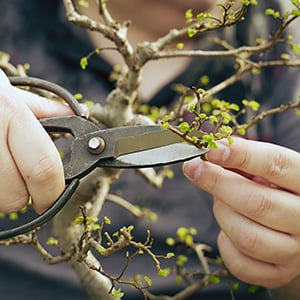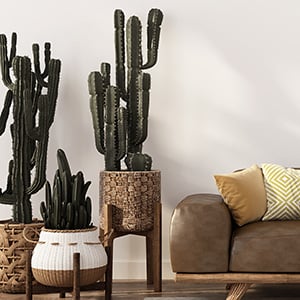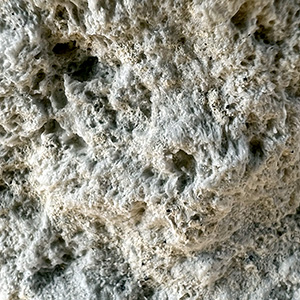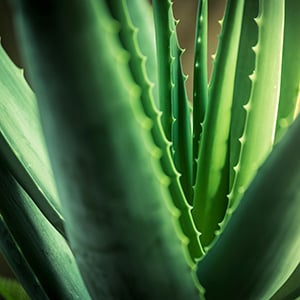


The beauty of a bonsai is found not only in its living art form, but in the devoted effort to skillfully shape and care for it. | Low-maintenance, visually engaging plants like cacti and other succulents are wonderful additions to interior spaces and potted gardens. | Extreme closeup of the foamed-stone surface of a typical Rūtsu pumice stone.
BUY RUTSU™
Pumice Grow Media
Pumice finds wide use in horticultural applications. In small, granular form, it can be blended with poor native soils to improve overall soil structure, or tilth, in high-value crop fields, garden soils, and landscapings. It fills the same role as expanded perlite does in engineered potting soils. It can be blended with manures and waste organic matter and improve the composting process itself. At larger stone sizes (grades) it functions as a soilless grow media in high-efficiency aquaponic and hydroponic grow systems. And as a grow media for enthusiasts who demand a high degree of control over the rooting environment of the plants they carefully shape and nurture, pumice provides exactly that.
Why This Pumice?
Pumice is abundant and found in many parts of the world, but not all pumice is created equal. Rūtsu™ grow media comes from a pumice deposit located in southeast Idaho on the shoreline of ancient Lake Bonneville...a vast, freshwater lake—a small inland sea, really—that once covered much of North America’s Great Basin region (most of Utah and parts of Idaho and Nevada). The Great Salt Lake is all that remains of Lake Bonneville. The volcano that produced the pumice is about a mile to the north of the mine. The volcanic ash (pumice) was deposited in the lake, where it was washed and stratified over centuries. The relentless wave process cleaned the pumice of the undesirable heavy minerals that are often found in other pumice deposits.
Pumice for Bonsai Soils
PUMICE HAS LONG BEEN USED as a stand-alone soil or a component in a soil blend by bonsai enthusiasts. There seems to be almost as many bonsai soil blend recipes as there are enthusiasts, evidence that no single media works for all trees at every stage of development and in all conditions. Bottom line: the soil components themselves must be selected and blended with an understanding of what best suits a particular tree in terms of drainage and water retention needs. Improper watering—an improper balance between media, tree type, container, and water—is the bane of successful bonsai. For most trees, the ideal balance is achieved when the tree needs water every 24 to 36 hours.
Rūtsu™ pumice grow media is available in three grade sizes to meet the specific and variable needs of individual bonsai plants. This provides the bonsai enthusiast with the flexibility to compose the ideal grow media blend for each tree in their collection.
Pumice for Cacti and Other Succulent Soils
SUCCULENTS, INCLUDING CACTI, love a soil that drains well, but holds onto moisture and nutrients long enough to meet the needs of the plant. That means a carefully balanced combination of soil type (grow media) and watering frequency. This dynamic, greatly influenced by climate, is the key to thriving succulents. Pumice, with its natural frothy-stone, nook-and-cranny-riven character, is widely used by succulent enthusiasts because it allows them to easily create and maintain that ideal balance.
RūtsuTM Grow Media: The Particulars
NOT SCORIA. Pumice is not scoria. Scoria is coarse lava rock, typically red, red/brown, sometimes black, and is often used as a decorative landscaping ground cover. Scoria forms from basaltic magmas, while pumice is of rhyolitic magma origin. The difference is important. Pumice has many more vesicles—trapped bubbles—than scoria and the walls between them are very thin. Pumice is essentially a foamed glass stone, amorphous (non-crystalline) in structure. The pumice from our deposit is neutral in pH, and more tightly structured (dense) than is typical of pumice—it does not (for the most part) float.
IDEAL FORM FACTOR. Pumice stones are intricately sponge-like in form factor, riven with holes and hollows of various sizes—from visible (macro) to unseen (micro). And yet, being a rigid amorphous silica glass, pumice doesn’t absorb moisture and swell. It doesn’t get soggy. Rather, pumice predictably retains moisture by virtue of its physical structure: 1) held within the tiny-to-microscopic pores in the foamy-stone, 2) caught on the rough, pocked, irregular surface, and 3) caught and suspended in the spaces between the foamed little stones themselves. This type of moisture retention is ideal for controlling drainage rates. One simply adjusts the stone size blend to dial up the desired drainage rate.
DRAINAGE RATE CONTROL. By making adjustments to the particle size blend, pumice soil can be mix-designed meet the moisture needs of a wide variety of plant-types in a wide variety of interior and exterior climates. A pumice-soil profile can also be blended to square with how often one likes to water. Drainage rates are built around grade (stone size) and grade blends: larger grades drain faster and retain less moisture than smaller grades. Small stones pack more tightly together and, consequently, hold more moisture for longer. By blending Rūtsu grades, drainage rates can be dialed in for plant type and pot size.
NUTRITION. By adding a quality liquid fertilizer to the water itself (common among bonsai enthusiasts), one can meet the plant’s nutritional needs and avoid the use of potting soils, composts, and problematic organic media altogether—pumice does not decompose or rot. The vast network of those micro pockets of retained water make liquid fertilizers and nutrients available longer between waterings.
SIFTED AND GRADED. Rūtsu Eights and Sixteenths have been dried and sifted to remove the fines. If water-retentive fines are needed in your soil blend (for a particular wet-loving deciduous tree, for example), blend in a bit of Fines grade.
DRIED AND PATHOGEN FREE. During processing, the Rūtsu Eights and Sixteenths grades are heated and dried, eliminating any chance of stow-away pathogens.
AERATION. Rūtsu stones are not uniform in shape, and thus provide ample air spaces between particles and amid the natural nooks and crannies found on the surface. The rough-hewn, finely-riven surface of each stone also provides ideal habitat for beneficial bacterial and mycorrhizae as well as grippy purchase for roots and decorative cover mosses.
OTHER CONSIDERATIONS. Pumice soil also finds a sweet spot in terms of weight. It is a lightweight stone, yet substantial enough not to blow or float away. It also provides enough weight to anchor a light pot, yet is easy on shelves and racks.
Pumice can also be used to amend succulent and cactus garden soils. Drainage rates can be greatly improved, and, where puddling tends to create problems, and top-dressing of pumice stone can insure the crown of the plant does not come in contact with soggy dirt.
Pumice is also a great media for rooting cuttings and offsets.
PUMICE PURITY. Our horticultural grades are typically comprised of 98% pumice and 2% other igneous minerals, which are not removed through our mining and drying processes.
SAY IT. Pronounced root-sue. Rūtsu is a Japanese word that translates to “roots.”
ADDITIONAL INFORMATION and SUPPORT DOCUMENTS







OTHER HORTICULTURAL PUMICE PRODUCTS
SoilRox™ Native Soil Amendment; Structural Conditioner
Ponics Stone™ Soilless Grow Media for ’ponics Systems



